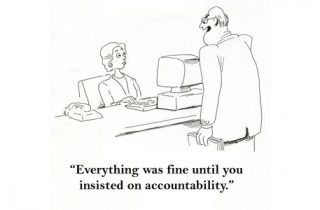Take a look at job descriptions in almost any organisation. You’ll find they’re broad statements of areas of responsibility or lists of activities. Job descriptions like this are concerned with activity rather than output, and fuel the culture of ‘hard work’ and long hours. What you don’t see is a list of the results people are accountable for producing.
We seem wired to think in terms of action and responsibility. As a consequence, our working culture is dominated by us trying to do too many things at once and only reacting to events. The result is we work long hours, exhibit stress and become irritable.
Given that we’re wired this way, we do what we believe we’re good at, what we like doing, or if all else fails, what’s most urgent! At more senior levels of management, where activity discretion is greater, this can produce teams of people working extremely hard but not producing required results.
Without accountability to measure the results of all this hard work, you don’t get the satisfaction that comes from knowing you have done precisely what is required and done it to the required standard.
Expressing accountability
There is a powerful way of defining a role that fosters a culture of output, results, satisfaction and recognition. What it requires is the time and mental rigour necessary to challenge the existing way of thinking, and think about the job in a new way. Individuals and teams who go through this process find that they have a new mental ‘map’ of their own role, that of each of their colleagues and that of the team as a whole.
They would describe their jobs differently – “I’m accountable for producing profitable new business, a motivated high-performance team, an efficient, best-practice business operation, and satisfied & delighted clients”. They would know exactly how each of these areas was measured and the exact status of their performance against each measure without having to look it up!
Redefining roles
How do you achieve this degree of clarity and rigour? Get the team together. Taking one job at a time, and using as a starting point the lists of areas of responsibility and associated activities in team members’ job descriptions, rigorously and meticulously group activities into themes. Now, question among yourselves what the output of each group or theme is. Don’t jump to quick conclusions but work together on each statement of output until you are all satisfied that it expresses exactly what you agree the role exists to deliver. Always work with an outside facilitator, to ensure that you miss nothing and don’t become bogged down in your existing view of the team.
In the process, every team member becomes absolutely clear on the outputs (usually no more than six) of his or her role, and how these are to be measured. Because the whole team has an input into each role, each team member is left confident that he or she is carrying out exactly the role required of them, to the right standards.
In the process, gaps and overlaps between roles are uncovered and resolved. Misunderstandings about the exact purpose of a set of activities are sorted out, and often whole groups of activity are dropped, as it becomes clear that they serve no useful function! The whole team knows exactly what it exists to produce, and each team member knows exactly what his or her unique contribution to that result needs to be. Added together over a whole organisation of any size, this focus on the deliverable outputs of every job will produce the results that everyone has committed to producing.
‘Unsticking’ the organisation
The questions asked in the ‘unique contribution’ process are straightforward and confronting. The process of getting clear, simple answers often presses sacred buttons that uncover the nature of the ‘stuckness’ in organisations: it forces misunderstandings, ambiguity, clashes and unwritten beliefs/rules into the open (another good reason to use an external facilitator!).
However, you will find that the effort involved is more than repaid. The process unlocks the commitment, passion and inspiration of the individuals who participate in it, and the work of the team comes together to produce more cohesive plans and greatly enhanced results, all with more collaboration, more recognition and far less ‘hard work’!


Using the RACI process to redefine roles ensures the accountabilities are clear and it’s then easier to define the behaviours required to deliver
Hi, Meriel, thanks for your comment. The RACI process is certainly useful in helping to untangle all the various accountabilities in a project management situation, but it doesn’t necessarily require exact specification of the deliverable output of each area of accountability that the process described in the article does. The Unique Contribution process is designed to focus an individual on what the precise deliverable output of each accountability is, so they can manage their own time and priorities to deliver the accountability on time. It also forms a very useful basis for performance management by the individual’s manager. Best wishes, Kate